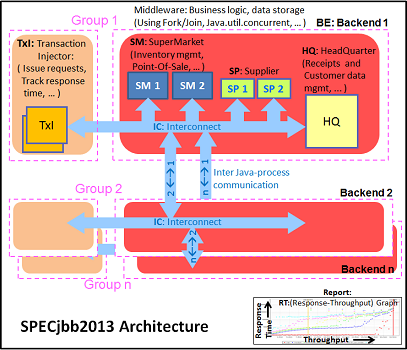The new Opteron 6300: Finally Tested!
by Johan De Gelas on February 20, 2013 12:03 AM ESTJava Server Performance
The SPECjbb®2013 benchmark is based on a " usage model based on a world-wide supermarket company with an IT infrastructure that handles a mix of point-of-sale requests, online purchases and data-mining operations". It uses the latest Java 7 features, makes use of XML, compressed communication and messaging with security.

We tested with four groups of transaction injectors and backends. We applied a relatively basic tuning to mimic real world use.
"-server -Xmx4G -Xms4G -Xmn1G -XX:+AggressiveOpts -XX:+UseLargePages-server -Xmx4G -Xms4G -Xmn1G -XX:+AggressiveOpts -XX:+UseLargePages"
With these settings, the benchmark takes about 40GB of RAM.

Since SPECJBB®2013 is very new, we will research the benchmark in more detail later. The first results are very interesting though. Notice how one Opteron 6380 edges out the Xeon 2660. Once we double the amount of CPUs, the Xeon outperforms the best Opteron by 17%. The fact that each Opteron processor is a dual NUMA node is not helping the Opteron. It is clear that the single die or "native octal-core" approach scales better here (for now).
SPECJBB®2013 is a registered trademark of the Standard Performance Evaluation Corporation (SPEC).










55 Comments
View All Comments
sherlockwing - Wednesday, February 20, 2013 - link
These Piledriver based Opterons look competitive but the threat of Ivy-EP is immenient. The last time Intel die-shrunk their High end platform they introduced the monsterous 10 core Westmere-EP(the current Xeon E7 lineup), I wouldn't be surprised Ivy-EP introduces 10/12 core extreme E7 Xeons as well as Octa Xeons with better performance/watt.Kevin G - Wednesday, February 20, 2013 - link
Ivy Bridge-E is indeed coming but it is looking to be 6 months out. These Opterons were shipping since November which would give them a 10 month lead time. The real question for AMD is what they'll have in response in that time frame. Steamroller based parts all look to be released in 2014. On the bright side, AMD should be pairing those chips with a new socket as DDR4 becomes available.One thing though about Ivy Bridge-E is that it will also be a socket 2011 part so migration to it should get relatively quick in comparison to the Westmere-EP to Sandybridge-E transition. The same cost savings for OEM noted in this article for socket G32 Opterons will apply to Ivy Bridge-E this time around.
Oskars Apša - Wednesday, February 20, 2013 - link
Wasn't intels 2011 socket to be only physically identical, but electrically totally redesigned?Hrel - Friday, February 22, 2013 - link
"These Opterons were shipping since November"I reject this statement. Nothing counts as being "on the market" until Anandtech has done a full review of it. That's my stance and I'm sticking to it :P
Beenthere - Wednesday, February 20, 2013 - link
...is that the 63xx series is focused primarily on micro servers where it fits well. If the just disclosed Jaguar cores are any indication of AMD products to be released this and next year, I'd say AMD is back in the game in many PC and portable markets.The only thing Ivy Bridge has going for it is reduced power but at a price penalty.
JohanAnandtech - Thursday, February 21, 2013 - link
SeaMicro was indeed one of first to use Piledriver based cores, but I don't think the Opteron 6300 is meant to be a "typical" microserver CPU. Otherwise, AMD would have focused more on low power parts. This meant to be an update for the general server market.Jovec - Wednesday, February 20, 2013 - link
... as it is showing the multi-threaded chart instead.JohanAnandtech - Wednesday, February 20, 2013 - link
Fixed. Thanks for pointing it out, always appreciated.Death666Angel - Wednesday, February 20, 2013 - link
Hey!I get a " Page Not Found" error from the Racktivity PDU link. :)
ssj3gohan - Wednesday, February 20, 2013 - link
You say that AMDs bad implementation of C6 costs them in the energy efficiency tests, but AFAIK with a low of still 10% CPU the CPU should not enter ACPI C3 (Intel C6), it will probably stay in C1e providing there is still more than enough workload to do on each OS tick.If the xeons are observed to go into ACPI C3, then that is very probably a scheduler optimization specific for intel processors, not an actual implementation problem by AMD. Balancing C-state transitions - especially complete core sleep modes like ACPI C3 - is a notoriously hard task to do because each transition also costs a certain amount of mJ that, on immediate wake, are wasted compared to just leaving the cores in C1(e)